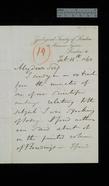Lists land birds of Galapagos and discusses their distribution on mainland of S. America.
Informs CD that Sylvicola aureola may be a distinct species but is a close ally of S. aestiva of N. and S. America and perhaps only a "climatic variety".
Discusses phases of climate.
Describes fossil mammals discovered by Auguste Bravard in South America.
Has had argument with Bishop of Oxford [Samuel Wilberforce] about CD’s book [Origin].
Discusses review in Annals and Magazine of Natural History. Guesses that T. V. Wollaston is the author.
Discusses evidence of shells on Madeira.
Comments on paper by Wallace ["On the zoological geography of the Malay Archipelago", J. Proc. Linn. Soc. Lond. (Zool.) 4 (1860): 172–84].
Questions how natural selection can explain why some cells remain simple and others are modified into highly complex structures.
Reports on the spread in Ceylon of a recently introduced plant.
Believes Origin makes science "young, clear, elevated" but does not have the facts to prove that cumulated slight modifications could ever produce different families from common ancestors. [See 2709.]
Arrangements for the American edition of Origin.
ACR has for years had a belief in mutability and transmutation of species, prompted by disputes over the nature of species and varieties, and the existence of representative species in space and in the geological record. Could not accept a Creator employing small miracles to make species differ just a little between formations. Has maintained that one would not expect to find fine gradations between forms in the fossil record, but only representatives of very populous forms. [See 2711.]
CD has caused a great change in HS’s views, in showing how a great proportion of adaptation should be explained by natural selection not direct adaptation to changing conditions. HS had remarked on the survival of the best individuals as a cause of improvement in man, but he "& every one" overlooked selection of spontaneous variation. Believes so many kinds of indirect evidence must add up to a conclusive demonstration of the doctrine.
Believes the British and Norwegian species of red grouse are merely strongly marked varieties of the same species.
Writes of the effect of importing a few brace of a wilder breed of grouse into Argyleshire and of their change in territory since 1846.
His explanation of game becoming "wilder": he thinks it is due to a difference in their enemies – man replacing hawks leads to flight replacing cowering.
Believes in the "perfect indefiniteness & frequently the vast length of the interval" between consecutive geological formations. Thus has little respect for arguments against CD based on the absence of transitional forms in the geological record. States that species found through series of beds do vary: some Silurian species have many synonyms which are really varieties of greatly differing ages. CD’s theory accounts for the progressive inprovement, multiplication and increase in complexity that can be seen, but which may often be only relative.
Returns paper by Asa Gray [? "Review of Darwin’s theory", Am. J. Sci. 2d ser. 29 (1860): 153–84].
Greatly admires Origin.
Can follow effects of natural selection in Carex, but when CD brings millions of years into play, he is like Church which demands faith. FB cannot believe in divinity of Christ, resurrection, or miracles.
Reports catching a landrail on board ship.
Encloses drawings of insects caught at sea.
W&N have not yet received the German edition of the Origin.
Recommend French–English and French dictionaries.
Has studied CD’s Jamaican hive-bees and finds them identical to Apis mellifica.
Discusses the structure of wasps’ and bees’ nests
and the occurrence of winged and apterous individuals within some insect genera and species.
Sketch and description of a [wasp’s] nest from Cuba. [Notes by CD on wasps’ nests and comb-building habits of hive-bees.]
CD elected correspondent of the Academy of Natural Sciences of Philadelphia.
CD’s observations on curved styles read well. JDH seeks morphological rationale of curvature in the position of nectaries.
He has avoided lecturing to Royal Family’s children at Buckingham Palace.
Has examined Leschenaultia and concludes the external viscid surfaces have nothing to do with the stigmatic surface. Agrees with CD’s style and nectary conclusions; accounts for their form and position in irregular flowers by describing floral development.
[Enclosed are some queries by CD with answers by JDH. Gives information on seed setting by Mucuna
and an opinion on the abruptness of N. and S. limits of plant ranges.]
Cannot supply a case of atavism in canaries.
Will lend CD back issues of Cottage Gardener.
Cites case of bird (tumbler hen) laying egg in another’s nest.
It is small comfort to be told you will be succeeded in lineal descent by angels when Lamarck and Darwin have made your ancestors without souls. However, can the progressive system not be seen as most consonant with a higher destiny if all spiritual natures advance? The link of common descent to inferior beings like idiots should be obvious. Infants die before they become responsible. Pope’s An essay on Man [1733] shows how man was "In doubt to deem himself a God or Beast", without speculation on his genealogy.








